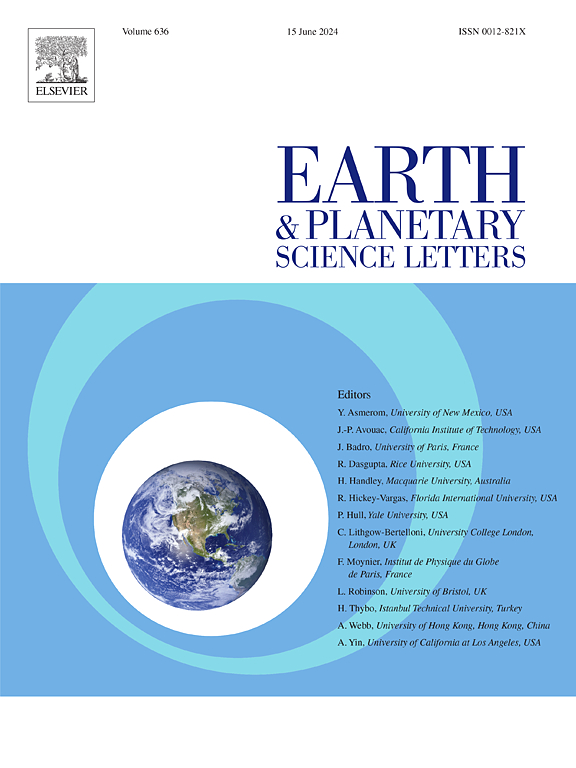Rhenium isotope variations in Icelandic groundwaters and hydrothermal systems
IF 4.8
1区 地球科学
Q1 GEOCHEMISTRY & GEOPHYSICS
引用次数: 0
Abstract
The isotopic composition of rhenium (Re) has potential for use as a proxy to infer changes in seafloor redox and/or global oxidative weathering intensity. Despite an emerging dataset on this nascent isotope system in Earth's surficial environments, very little is known about processes that control Re isotope fractionation, nor the isotopic composition of hydrothermal systems. Here we present Re concentrations and Re isotopic compositions (reported as δ187Re, relative to NIST 3143) of groundwaters and hydrothermal fluids from three Icelandic settings. First, we show that high-temperature fluids that have experienced vapour-phase segregation (boiling) from the Reykjanes peninsula and the Hengill volcanic system have the highest δ187Re values (−0.01 to +0.34 ‰) observed to date, inferred to result from Re isotope fractionation during incorporation of Re into secondary reduced minerals. Second, we examine the Mývatn area in northern Iceland, which has both cold and warm groundwaters. Cold groundwaters (< 10 °C) have δ187Re values indistinguishable from Icelandic basalts (−0.36 to −0.32 ‰) whilst warm waters have higher δ187Re (−0.31 to +0.19 ‰) which increase with increasing temperature (up to 45 °C). The variation of δ187Re in Mývatn groundwaters is closely mirrored by variations in δ98Mo, consistent with mixing between compositionally distinct water end-members. Finally, geothermal waters from the Geysir field have variable Re concentrations and δ187Re values (−0.23 to +0.34 ‰), likely reflecting multiple physico-chemical processes. Using these results, we show that hydrothermal activity is unlikely to exert a large net impact on the seawater Re budget, nor the secular changes in seawater δ187Re. These findings also point toward developing a novel Re isotope tracer for redox processes.
冰岛地下水和热液系统中的铼同位素变化
铼(Re)的同位素组成有可能被用作推断海底氧化还原和/或全球氧化风化强度变化的替代物。尽管有关地球表面环境中这一新生同位素系统的数据集正在不断涌现,但人们对控制铼同位素分馏的过程以及热液系统的同位素组成知之甚少。在这里,我们介绍了冰岛三种环境中地下水和热液的 Re 浓度和 Re 同位素组成(以 δ187Re 报告,相对于 NIST 3143)。首先,我们展示了雷克雅未克半岛和亨吉尔火山系统中经历过汽相分离(沸腾)的高温流体具有迄今为止观测到的最高δ187Re值(-0.01 至 +0.34‰),推断这是由于Re在融入二次还原矿物的过程中发生了同位素分馏。其次,我们考察了冰岛北部的 Mývatn 地区,该地区既有冷地下水,也有暖地下水。冷地下水(< 10 °C)的δ187Re值与冰岛玄武岩无异(-0.36 至 -0.32 ‰),而暖地下水的δ187Re值则更高(-0.31 至 +0.19 ‰),并随着温度的升高而增加(最高可达 45 °C)。Mývatn 地下水中 δ187Re 的变化与 δ98Mo 的变化密切相关,这与成分不同的水末端分子之间的混合是一致的。最后,盖希尔气田的地热水具有不同的 Re 浓度和 δ187Re 值(-0.23 至 +0.34‰),可能反映了多种物理化学过程。利用这些结果,我们表明热液活动不太可能对海水 Re 预算产生巨大的净影响,也不太可能对海水 δ187Re 的长期变化产生巨大的净影响。这些发现也为开发氧化还原过程的新型 Re 同位素示踪剂指明了方向。
本文章由计算机程序翻译,如有差异,请以英文原文为准。
求助全文
约1分钟内获得全文
求助全文
来源期刊

Earth and Planetary Science Letters
地学-地球化学与地球物理
CiteScore
10.30
自引率
5.70%
发文量
475
审稿时长
2.8 months
期刊介绍:
Earth and Planetary Science Letters (EPSL) is a leading journal for researchers across the entire Earth and planetary sciences community. It publishes concise, exciting, high-impact articles ("Letters") of broad interest. Its focus is on physical and chemical processes, the evolution and general properties of the Earth and planets - from their deep interiors to their atmospheres. EPSL also includes a Frontiers section, featuring invited high-profile synthesis articles by leading experts on timely topics to bring cutting-edge research to the wider community.
 求助内容:
求助内容: 应助结果提醒方式:
应助结果提醒方式:


